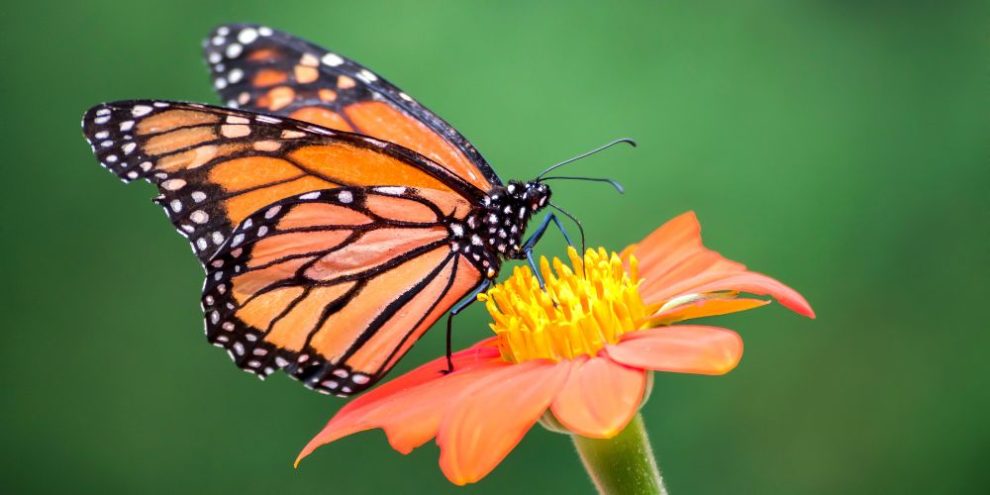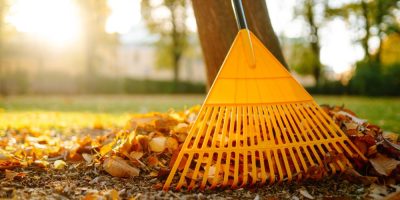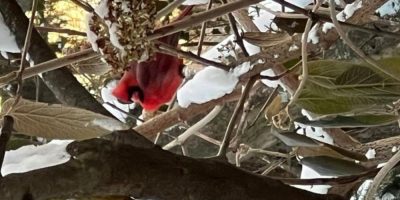
If you’ve ever spotted a flash of orange and black fluttering through your backyard or a field of wildflowers, chances are you’ve crossed paths with one of nature’s most iconic insects — monarch butterflies.
They’re beautiful, no doubt. But monarchs are also surprisingly complex. From their awe-inspiring migration to their fragile place in our ecosystem, there’s a lot more to these butterflies than meets the eye.
Whether you're just butterfly-curious or a full-on monarch enthusiast, here’s everything you need to know.
Barrie's News Delivered To Your Inbox
By submitting this form, you are consenting to receive marketing emails from: Central Ontario Broadcasting, 431 Huronia Rd, Barrie, Ontario, CA, https://www.cobroadcasting.com. You can revoke your consent to receive emails at any time by using the SafeUnsubscribe® link, found at the bottom of every email. Emails are serviced by Constant Contact
The monarch life cycle
Like all butterflies, monarchs undergo complete metamorphosis, which sounds intense because it is.
Their life cycle has four distinct stages, and each one is a marvel in its own right.
Egg
It starts small. Really small.
A monarch egg is about the size of a pinhead and usually laid on the underside of a milkweed leaf. Females lay between 300 to 700 eggs … but each is laid one at a time and only about 1% survive to adulthood. If a female lays 400 eggs, only about 4 may become adult butterflies.
Caterpillar (larva)
This stage is all about growth.
Once hatched, the tiny caterpillar eats its eggshell and then gets to work on the milkweed. Monarch caterpillars will shed their skin five times as they grow up to 2,000 times their original size. That’s like a baby growing into a school bus in two weeks.
Chrysalis (pupa)
After about 10 – 14 days of nonstop munching, the caterpillar finds a safe spot, hangs upside down, and forms a bright green chrysalis. Inside, something almost magical happens … the caterpillar dissolves and restructures into a butterfly.
Adult butterfly
After another 10 – 14 days, the monarch emerges. It takes a few hours for its wings to dry and harden, and then it’s ready to fly.
The average lifespan of a monarch butterfly is 2 to 6 weeks, with many generations being born each year.
Monarchs and milkweed: A love story
These days, you can’t really talk about monarchs without someone bringing up milkweed. And there’s an important reason for that!
Milkweed isn’t just their favorite plant – it’s their lifeline.
Monarch caterpillars only eat milkweed
While monarch butterflies can eat the nectar of many different plants, monarch caterpillars can only eat milkweed.
You see, milkweed contains a toxin called cardenolide that monarchs have adapted to tolerate. It acts as a built-in defense system, making the caterpillars poisonous to predators like birds.
The problem is, they became so well adapted to it that it’s the only food monarch caterpillars can eat.
Monarchs only lay eggs on milkweed
Because monarch caterpillars only eat milkweed, butterflies must lay their eggs on these plants.
And that's why no milkweed means no monarchs.
Where are monarchs found?
Monarch butterflies are found across North, Central, and South America, but they’re most famous for their populations in North America.
Here in Canada, monarchs can be found across the country. While there are some monarchs high in the Rockies, populations are low due to the cooler climates and lack of resources.
Instead, monarchs stick to the southern regions of Canada, with their northernmost distribution is south central Ontario including:
- Toronto and the GTA
- Niagara Region
- Simcoe County
- Ottawa Valley
- Southwestern Ontario (Windsor, London, etc.)
Migration: A 4,000 km journey without a GPS
Monarch butterflies are the only butterflies known to migrate both north and south, like birds do.
Each year, monarchs in eastern Canada travel up to 4,000 kilometers (2,500 miles) to overwinter in the mountain forests of central Mexico. (Monarchs in western Canada go to California to overwinter).
How do they do it?
Scientists are still figuring it out, but monarchs seem to use a combination of:
- The sun’s position
- Earth’s magnetic field
- An internal circadian clock
Even more impressive? The butterflies that fly south in the fall have never made the journey before. They’re born with the instinct to go.
Migration is a one way trip for the monarch butterfly
Unlike birds, a single monarch butterfly will never make the round trip from Canada to Mexico and back again. This has to do with their short lifespans.
As I mentioned earlier, the typical lifespan of a monarch butterfly is 2 to 6 weeks. But, as you’ve likely deduced ... this doesn’t leave them much time to get to Mexico from Eastern North America.
Introducing the Super Generation
This is where things get interesting … The last monarchs born in the year (known as the super generation) can live up to 9 months.
These super monarchs do not reproduce right away, unlike previous summer generations. Instead, they begin migrating south almost immediately, triggered by shorter daylight hours and cooling temperatures.
The trip to Mexico
As they travel towards Mexico, they stop along the way to eat at nectar-rich flowers like goldenrod, asters, coneflowers, and zinnias. While monarchs never follow the exact same path, some of their major stopover points are:
- Point Pelee National Park (Ontario): Major gathering spot before crossing Lake Erie.
- Rondeau Provincial Park (Ontario): Another key staging area in southwestern Ontario.
- Monarch Watch Waystations (across the Midwest): Especially in Michigan, Ohio, Illinois, and Iowa—many gardens, prairies, and parks provide nectar.
- Kansas & Oklahoma prairies: Rich in native wildflowers that monarchs depend on.
- Texas Hill Country (near San Antonio and Austin): A vital “last-chance” feeding zone before they cross into Mexico. Nectar-rich and widely studied.
- Cape May, New Jersey: Famous for monarch monitoring – huge congregations seen here.
- Outer Banks, North Carolina: Another coastal spot with good nectar sources.
These “fueling stations” along the way are so important that scientists and conservationists encourage people to plant pollinator-friendly gardens and preserve native wildflowers to help support monarchs on their journey.
Surviving winter in Mexico
As the Monarchs get closer to Mexico in October/November, they go into a state of dormancy or suspended development known as dispause.
During this time:
- They don't eat
- Their metabolism slows down
- They rely on fat reserves stored up during their journey
- They may still drink water or nectar occasionally, but they don’t feed actively
This allows them to survive the winter months in Mexico’s mountain forests where food is scarce.
A new generation heads north
When they wake from diapause in March or April, they begin their journey north again, laying eggs on milkweed in northern Mexico, Texas and other southern states. These eggs hatch into caterpillars, become butterflies, then continue the migration north.
Between late May and early July the grandchildren and great-granchildren of last year’s monarchs return to Canada.
Fun and fascinating monarch facts
Need a butterfly trivia fix? Here are a few cool things you may not know about monarchs:
- Monarchs can see ultraviolet light.
- They “taste” with their feet.
- Some believe that the name "monarch" refers to King William III of England, aka the Prince of Orange.
- They weigh less than a paperclip.
- During migration, they can fly over 80 kilometers in a single day.
- Viceroy butterflies are sometimes confused with monarchs. The easiest way to differentiate these two butterflies is by their hindwing vein. Viceroy have a black line that goes across the entire hindwing; monarchs do not.
- Monarchs have a fascinating relationship with certain species of fungi. The parasitic fungus Entomophthora infects some monarchs, changing their behavior and causing them to "migrate" to places where the fungus can spread to other bugs. It’s an eerie example of how nature can sometimes work in unexpected ways!
- In Mexico, Monarch migration coincides with the day of the dead. In some cultures, these butterflies are celebrated as the souls of ancestors.
- Monarchs play a key role in their ecosystems as pollinators. While milkweed is critical to their survival, they also help pollinate other plants they visit during migration, contributing to the health of wildflower populations.
Monarchs are in trouble
Here’s the hard truth: monarch butterfly populations have dropped dramatically in recent decades.
The eastern population, which migrates to Mexico, has declined by over 80% since the 1990s.
The western population – those west of the Rockies who overwinter in California – is at even greater risk. In some years, their numbers have dropped by more than 99%.
What’s causing the decline?
Several factors are working against the monarch butterfly:
Predators: Ants, spiders, wasps, and birds often eat eggs, larvae, and pupae.
Parasites and disease: Including the protozoan parasite Ophryocystis elektroscirrha (OE), which can weaken or kill monarchs.
Weather: Heavy rains, droughts, or sudden cold snaps can destroy eggs and larvae.
Habitat loss: Fewer milkweed plants mean less food and fewer safe places to grow.
Pesticide and herbicide use: Chemicals used in agriculture and landscaping can kill monarchs directly or eliminate milkweed and nectar plants they depend on.
Climate change: Shifts in temperature and precipitation patterns can disrupt migration timing, breeding cycles, and food availability.
Deforestation in Mexico: Illegal logging in overwintering sites reduces the protective forest cover monarchs need to survive the cold and stay safe from storms.
RELATED: The number of monarch butterflies at their Mexico wintering sites has plummeted in 2024 ...
How you can help monarch butterflies
You don’t have to be a scientist to make a difference. Even small actions can support monarch populations.
Here’s how you can help:
- Plant native milkweed in your yard or garden
- Grow nectar-rich flowers that bloom from spring through fall
- Avoid using pesticides or herbicides
- Join citizen science projects like Monarch Watch or Journey North
- Share what you know—awareness helps conservation
Why monarchs matter
Monarch butterflies are more than just pretty wings. They’re pollinators, environmental indicators, and a symbol of connection between people and nature.
Their survival depends on all of us—from farmers and scientists to gardeners and kids planting milkweed in their schoolyards.
So next time you see a monarch drift by, pause for a second. You’re watching a traveler, a survivor, and a reminder that small things can make a big impact.
Frequently Asked Questions About Monarch Butterflies
Monarch lifespans vary by generation. Summer generations typically live 2 to 6 weeks, while the migratory generation that flies to Mexico can live up to 8 or 9 months.
As caterpillars, monarchs feed exclusively on milkweed. Adult butterflies drink nectar from a wide range of flowers including goldenrod, coneflowers, and milkweed.
Globally, the Migratory Monarch Butterfly Danaus plexippus ssp. plexippus is currently listed as Vulnerable on the IUCN Red List due to habitat loss, climate change, and declining milkweed populations.
In Canada, however, the Monarch is an endangered species under the federal Species at Risk Act (SARA).
Monarch are endangered due to habitat destruction, pesticide use, climate change, and loss of milkweed — the only plant their caterpillars can eat.
To survive, monarchs need milkweed to lay eggs and feed caterpillars, flowering plants for nectar, safe overwintering habitats, and favorable weather during migration.
Yes. Monarchs absorb toxins from milkweed as caterpillars, which makes them toxic to many predators. Their bright orange colour is a warning sign in nature. There is no evidence that they are dangerous to humans.
Monarchs are symbols of transformation, rebirth, and hope. In Mexico, they are linked to Día de los Muertos, believed to represent returning ancestors’ spirits.
Monarchs begin laying eggs in early spring through summer, depending on the generation. Each female can lay hundreds of eggs during her lifetime.
Monarchs migrate south in the fall (September–October) and return north in the spring (March–April), completing a multi-generational journey.
They migrate to avoid freezing temperatures. Monarchs can’t survive cold northern winters, so they travel to warmer regions to overwinter.
Monarch butterflies migrate to central Mexico, specifically the oyamel fir forests in the mountains of Michoacán and the State of Mexico. These high-altitude forests provide the cool, moist conditions monarchs need to survive the winter. Western populations in North America migrate to coastal California.
Monarchs live across North, Central, and South America. In Canada, they are found in southern regions during summer, especially where milkweed grows.
Monarchs typically remain in the chrysalis (pupa) for 8 to 15 days, depending on temperature and environmental conditions.
Monarch butterflies are native to North America but have spread to parts of Australia, New Zealand, and other regions due to human activity.
A single female monarch can lay 300 to 500 eggs during her lifetime, usually one egg per milkweed leaf to ensure caterpillar survival.
The monarch migration involves four generations. Three generations live short lives and move north over the spring and summer. The fourth is a special “super generation” that migrates to Mexico in the fall and lives the longest.
The Viceroy butterfly closely resembles the monarch. It mimics the monarch’s coloring but can be distinguished by a horizontal black stripe across its hindwings.
Monarchs are bright orange with black veins and borders, and white spots on their wings. Their vivid colouring serves as a warning to predators.
Monarch butterfly caterpillars are easily recognized by their bold black, white, and yellow stripes. They have a smooth, elongated body with pairs of black tentacle-like filaments—two near the head and two near the tail. They’re typically found on milkweed plants, where they feed exclusively.











